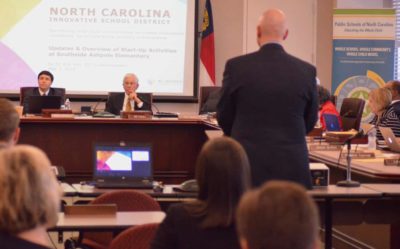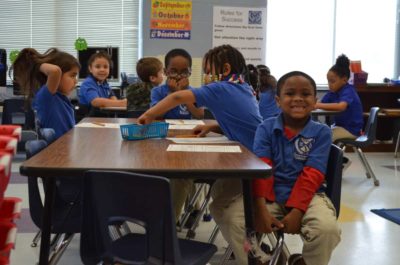In the wake of Governor Roy Cooper’s announcement last week of a statewide supply drive for schools, the issue of classroom resources moved front and center.
During his announcement, Cooper criticized Republican lawmakers for not including in their budget his proposal of a $150 stipend for teachers to purchase school supplies.
Both that proposal and the supply drive are meant to fix a problem Cooper said he hears complaints about from teachers around the state: inadequate classroom resources.
He cited a Forbes study that found that teachers spend, on average, $500 of their own money on school supplies each year.
All of this raises the question: how are school supplies funded, and what is the impact on teachers?
Are there enough funds for school supplies?
Much of the discussion around school supplies often falls at the feet of the state government. Critics of education spending lay the blame there because the bulk of education funding comes from the state coffers. So, how much money does the state give for school supplies? A little more than $30 per student in the 2016-17 school year, according to the state Department of Public Instruction.
Ok. But what are school supplies? Well, take a look at the governor’s wish list for his school supply drive.
He is asking for things like paper, pens, pencils, notebooks, and tissues and sanitizing wipes. You may recognize some of those items as things that belong to students and which schools request parents provide.
LaTarzja Henry, executive director of community partnerships and family engagement with Charlotte-Mecklenburg Schools, said those lists have morphed over time.
It used to be just items that belonged to the students, like notebooks and pens, but has now extended to communal items like hand sanitizer. But these are the kinds of things we are talking about when we talk about school supplies.
Supplementing the state funding for these items are local supplements. Depending on the county, teachers may get more funding for supplies from their districts. A more affluent urban school system like Charlotte-Mecklenburg or Wake County is going to have more resources than a rural district like Harnett County Schools. So the need for school supplies is likely going to be greater in rural areas.
Additionally, some schools and districts are also able to use federal funds to purchase school supplies. Henry said the need in her district varies according to school, especially since some Title I schools can draw on greater resources provided to them by the federal government to supplement supplies.
An additional difficulty is that sometimes teachers want to provide lessons that require resources in excess of what is provided by the state or even the district, Henry said.
“A lot of times that is above and beyond what they’re provisioned for,” she said.
Charlotte-Mecklenburg has close to 9,000 teachers, Henry explained, and it is going to be tough for the state or the district to give those teachers everything they need or want.
In that case, the community comes into play. Businesses and churches may donate supplies to schools. Individuals have their own supply drives. Stores offer discounts to teachers to purchase supplies. And one non-profit in Charlotte, Classroom Central, actually provides teachers free classroom supplies that it collects throughout the year.
Henry said the Charlotte non-profit was developed because of teachers’ need for supplies, but also because of an understanding that businesses often discard supplies that could be perfectly usable in the classroom.
So, even in a district as relatively well-off as Charlotte-Mecklenburg, you’re seeing a slew of strategies for making sure classrooms are well-supplied.
Another large district, Wake County, also relies on partnerships with the community, the PTA, and others, not to mention the goodwill of teachers.
Ruth Steidinger, principal of Olive Chapel Elementary School, said teachers have had to supplement classroom supplies since she was a teacher more than two decades ago.
“I taught 24 years ago, and I know even then I spent some of my own money on my classroom,” she said. “I don’t think that’s changed.”
There will always be unexpected supply needs and teachers who want something extra for a special project or lesson plan. Still, Steidinger said the state could do more.
“I do believe that we could certainly do better than we currently are as a state,” she said. “But when is enough enough? I don’t know. That’s the million dollar question I guess.”
Wake and Charlotte-Mecklenburg are both relatively large and wealthy districts. What about in a rural district with less resources, like Harnett County?
Superintendent Aaron Fleming said his district faces challenges.
The Harnett County school district is one of the larger low-wealth school districts in the state. Fleming said the district is able to give schools some money for classroom supplies, but most of its local allotments goes to reducing classroom sizes.
Harnett often has to rely on the generosity of businesses in the community, parents, and teachers.
“I don’t think enough press is given to it, because teachers will go to a store, an office supply store…and they buy these things out of their pocket and give them to kids,” Fleming said.
Teachers do not want the recognition, Fleming said, and neither do others who donate to schools.
“A lot of people think that stuff just magically shows up,” he said.
But when it comes to school supplies, money for field trips, or any other expense needed to educate students, Fleming said Harnett County makes sure as a community that students have the same opportunities no matter their economic status.
Fleming does not know if there is a way to figure out exactly how much money school districts need from the state in order to be adequately supplied. The need fluctuates depending on curriculum and what any particular teacher needs to carry out the lesson plans he or she has prepared. He has seen the situation from both sides. He used to be the education advisor for House Speaker Tim Moore, R-Cleveland.
“I don’t know that question can ever be answered,” he said.
Fleming said teachers also have a self-interest in buying supplies for students. If their students are not prepared for classes, they cannot do their jobs.
“It’s a community effort, but certainly I think teachers do spend a lot of their own money because they want those kids to be successful.”
Terry Stoops, vice president for research and director of education studies at the right-leaning John Locke Foundation, said the sufficiency of school supplies really depends on who you ask. He also wonders if districts and schools are using all the resources available to them.
“Who determines what’s sufficient?” Stoops asked. “And who determines whether the supplies are being used in a productive manner?”
He said teachers use a tremendous amount of copy paper, for example, and that he wonders whether schools could find alternatives that would alleviate the need to purchase more paper or ask parents to provide it.
He also said the advent of technology should have lessened the demand for certain types of school supplies.
“With all the technology that we continue to have in schools, you would hope it would reduce the need for some of those conventional school supplies,” he said.
But, Stoops said, that has not happened.
“There still seems to be a tremendous emphasis on paper and pencils to complete classroom tasks,” he said.
Stoops said it is, however, clear that teachers do not have enough supplies, and he thinks something should be done for them.
“I’m pretty sure that everyone understands that teachers do have a burden in providing supplies in schools, and that perhaps even a larger tax deduction for teachers who do that is warranted,” he said.
The federal government, for instance, offers a $250 deduction related to school supplies, but there is no state equivalent.
Stoops said it is not just teachers being burdened by the cost of school supplies. Schools send supply lists home to parents who are expected to purchase items for their children.
“Kids are walking into the school on their first day with boxes full of supplies that were requested by those teachers,” he said.
This leads to another possible imbalance. Some parents are better equipped to provide supplies for their children than others. So districts with a great number of affluent families are more likely to be better supplied than districts with a large quantity of economically disadvantaged students. In these districts, teachers may feel the need to make up for what parents cannot give.
Ultimately, the money the state gives to districts could be used in a better way that might help address this issue, Stoops said. Many state funds are expected to be used on specific items by districts, but if those requirements were lifted, schools would have the funds they needed to use as they see fit.
“If you give them the flexibility to be able to use that money to address their needs, that would be a much more sensible way to craft the budget,” Stoops said.
What is the situation like on the ground? How do teachers feel about the burden of purchasing school supplies?
The teachers weigh in
EducationNC asked teachers using our Reach NC platform to tell us what they’re facing in the classroom. Across the board, the teachers who responded said they have inadequate resources and that they often have to personally supplement the lack of classroom supplies.
Many times, students come to the teacher and say they cannot afford the supplies. At our school, we have resources for that, but not enough for everyone who needs it. Most teachers I know go out and buy those supplies themselves including myself. When you are in a classroom day in and day out, you develop such a bond with the students. It is painful to witness students who are lacking the best resources to learn. We just won’t accept that.
— Ann Bruun-Andersen
My mom donates school supplies to cover my entire class knowing that the kids will not come with the supplies. I work in a free breakfast/free snack/free lunch school. We can’t ask the kids to spend money on notebook paper when they can’t afford to eat. I spend as much as my mom does throughout the year restocking supplies. It’s sad that the little raises we get don’t even cover what we spend in a year.
— Christie Dixon Ganshert
It’s worse than ever now. I could probably make do with a bare classroom, no fun rewards for students, and only ancient textbooks instead of new learning materials for students, but that’s not what’s best for the kids. I always spend way too much of my own money each year to make up the slack.
— Lisa Clifford
In the world of high school, we get the short end of the stick. If I want anything extra for labs and activities I must supply it myself.
— Cristina Elyse D’Agostino
On Facebook, individuals — not necessarily just teachers — proposed solutions to the issue of a lack of supplies, while others explained alternate ways that teachers get supplies in-state and elsewhere.
How do we get the money for our schools into the classroom? Maybe we should start looking at where and how it’s spent. I think we should look at the administration for the districts to find ways to consolidate and trim the proverbial “fat”. Our district hired an assistant to the superintendents assistant. That’s a salaried position. There’s no wonder that teachers and students don’t have the things they need, when we spend more money on positions for people who have no contact with the students.
— Jenny Ball
I am originally from New York State, where I taught for 17 years. There, teachers are given a certain amount of money to purchase classroom supplies and materials. Each district budgets for classroom supplies and allows each teacher to purchase what he/she needs.
— Jim Kellogg
I have been taking advantages of the school supply sales in hopes to have a “stock pile” of supplies that will last throughout the year.
— Stephanie Ball Patton
There was a town in NJ (Nutley) where they diminished the ranks of administrators and cut the salaries of those who remained. This strategy worked very well for them.
— Jane Mellin
I would rather buy the items myself and be allowed a deduction on my state taxes beyond the $250 allowed on the federal 1040.
—Brandi Bryant
One teacher responded to our Reach NC inquiry by emphasizing that her school tells parents they do not have to buy supplies because they are entitled to a free public education.
Our school doesn’t adequately order supplies that the teachers use. When we need more supplies, there is no money to purchase them.
Our parents get a note on their school supply lists that tells them that they are entitled to a free public education and therefore are not required to purchase school supplies. Last year, I had 6 students bring in supplies. We are a Title I school, and our supplies on our list can be purchased for less than $10. I spent the year buying tissues, composition books, and paper.
This doesn’t include supplies I must have to do my job such as chart paper, chart markers, staplers, and books. These books are classroom supplies that our students use each and every day, yet as teachers we must buy our own books and create a classroom library. Pencil and papers are cheap, but books are expensive.
Another said schools should operate more like workplaces do in the private sector.
Schools should have the funds to purchase supplies for teachers like normal businesses who provide their staff with office supplies.
One teacher said the issue is a problem for both families and teachers.
A lot of is asked of families and even more is asked of teachers and even with all of those supplies, there is still a shortage midyear. Recently the school secretary mentioned that our supply warehouse was empty.
Another teacher just said buying supplies for students is cost-prohibitive.
It would be a lot easier if I made enough money to do it.
The Governor’s school supply drive started earlier this week.
It runs until September 8, and people interested in donating school materials can drop them off at branches of the State Employees Credit Union, state government offices and businesses that partner with the North Carolina Business Committee on Education.
Requested supplies include:
- All types of paper
- Pens, pencils, and dry erase markers
- Spiral notebooks
- Tissues and sanitizing wipes
For those who want to start a supply drive at their own place of business, a school supply drive kit is available. It can be found here.
If you would like to continue the conversation about school supplies, text SUPPLIES to 63735.
Recommended reading




